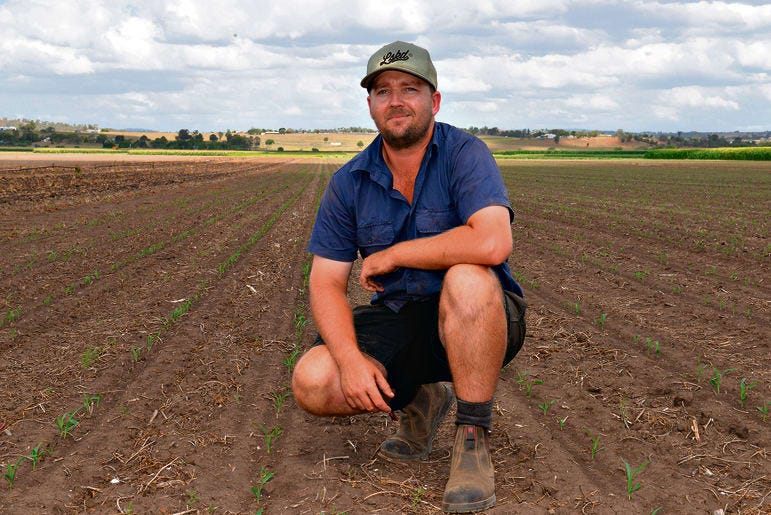Can farmers save our soil – and fix the climate?
by JOE HINCHLIFFE
Scott Moore hasn’t seen the latest Netflix documentary about saving the world from climate change.
But the fifth-generation Kalbar farmer had already switched to some of the techniques featured in Kiss The Ground when he took over the family farm about three years ago.
Sure he did so, in part, for the environment. In part it was to save money.
But, mainly, it just made sense for his property.
Mr Moore’s farm runs between Warrill Creek and Kents Lagoon. When not in drought, it’s land that floods a lot.
And if the rich soil in which he grows his vegetables has been recently tilled, the black gold washes away in heavy rain.
So, the 28-year-old grower stopped tilling it. Simple as that.
Actually, it was a practice his father had been doing for years. The young farmer just did it more. And when he does plough, he’s more targeted about it. Instead of ripping up an entire paddock to plant a new crop, Mr Moore uses a strip-tiller to turn narrow lines of soil in which the seed will be planted, and leaves the spaces in between untouched.
Using this strip-tilling technique, Mr Moore won’t turn the ground again until he plants the next crop.
“We’re seeing the benefits from doing it now,” Mr Moore said.
“It's saving a lot of time, wear on the machines and a lot of diesel costs.”
The land is responding too.
“Our soil is getting a lot softer,” he said.
“We find worms now in the soil where we couldn’t before. We’re not killing everything with cultivation.”
Conventional, modern cultivation practices can involve ripping up a paddock four times before planting.
It’s “very intensive” and it changes the soil’s structure.
“When the harvester comes, if it gets wet, they get bogged,” Mr Moore said.
“You get wheel marks two-feet deep in the dirt and it takes a long time for the soil to recover.
“With no-till, and strip-till, we’ve had crops of sweet corn that had two inches of rain the day before harvest.
“The harvesters come in and didn't mark the paddock at all.”
Like any techniques, minimal tillage has its drawbacks, he said. And it doesn’t work for every crop.
Mr Moore uses strip- or no-till on about three quarters of his 77 hectare property to grow crops like sweet corn, mung bean and barley.
But he still uses standard techniques to grow green beans and celery.
“They’ve gotta have a raised bed so they’re not sitting in water,” he said.
Similarly, root crops like carrots, which require ground “nice and perfect” are suited to heavy ploughing.
The techniques present challenges when it comes to using fertilisers and herbicides too. But, overall, it’s paying off.
“Our crop yields are better than we’ve ever had,” Mr Moore said.
“So we’re not doing any damage, and we’re also saving money.”
And Mr Moore believes there will be a long-term trend towards more sustainable farming techniques.
In the future, he said, “more people are going to be looking into that stuff”.
One of those who plans on doing the looking is Aria Salan.
The veterinary nurse is studying a bachelor of environmental science with a focus on soil and water and Griffith University.
A “horsey person” who grew up in Warwick and now lives outside of Beaudesert, Salan shudders at the sight of bare paddock.
But far from being anti-farmer, Salan thinks primary producers hold the key to tackling global warming.
“I think farmers will be the most important people in our society,” Salan said.
“Because they’re the ones managing the land, and land is what can save us.”
Salan said soils are a “wonderful carbon sink”.
The young scientist can talk “soil cycles, carbon, nitrogen and all the chemistry stuff are probably not all that interesting to most people”.
“But, basically, soil can capture carbon dioxide and store it as a solid mass,” Salan said.
“In doing that, you’re taking something in the atmosphere that is bad and turning it into something that is good for the soil.”
Growing up and living rural, Salan sees “a lot of climate denialism”.
But when it comes to farming, at least, “at the end of the day, it doesn’t really matter”.
“I know climate change is happening and science agrees on that almost unanimously,” Salan said.
“But even if it wasn't, these techniques are going to make farming more efficient.”
Salan’s focus is on grazing land. By improving paddock rotation and planting more trees and deep-rooted native grasses, Salan said graziers can cultivate carbon-rich and aerated soils that hold water and nutrients better.
“Grazing covers 50 percent of the land mass in Australia,” Salan said.
“If we can use that to sink up carbon in the atmosphere and meanwhile ensure food security, everyone wins.”
For farmers like Mr Moore, those wins aren’t just about improving the yields of today.
The Kalbar grower said he aimed to farm until he “can’t anymore”.
Then he hopes to be able to hand the property on to his own children. But that depends on doing right by the land.
“If we keep doing things that are no good for the soil, we’re not going to be able to farm forever,” he said.
“We’ve gotta look after the soil. At the end of the day, that’s all we’ve got and that's how we make money.”
“If you’ve got healthy soil to start with, well, you’re in front.”

